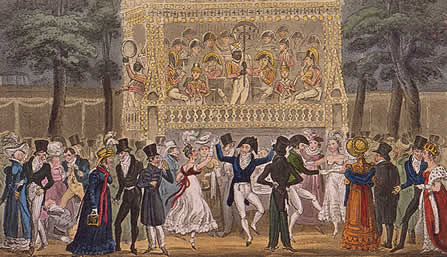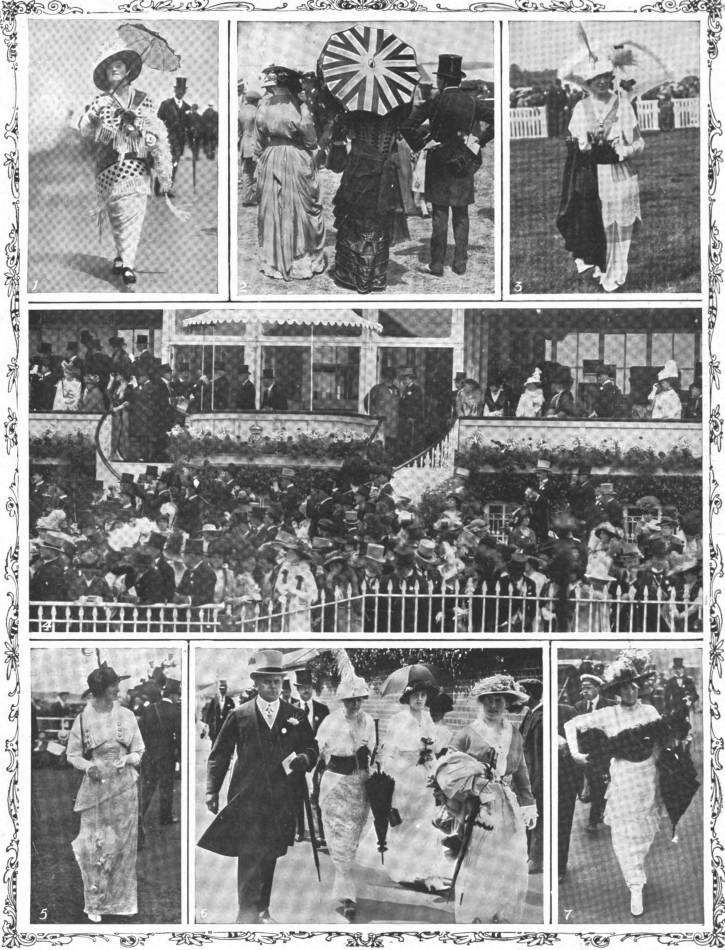 Victorian interior design was characterized by three words: gaudy, ornate and formidable. Following fashion, private and public rooms were stuffed with objets d’art, bric-a-brac, heavy velvet drapery, tables, chairs, paneled walls, Oriental rugs, potted plants, gilded reproductions of Louis XVI furniture—intricately carved, fragile sofas and chairs—Chinese ivory figures, German porcelain vases, ormolu clocks, and miniatures lined the fireplace mantle, the mantle itself shaded by heavy, ornamental fire-shades, and all was overlooked by wall to wall portraits and priceless paintings, richly framed in gold. Rooms in the same house could run the gamut from the “Louis” style so popular with Americans, to the Moorish and Oriental decor transported West by fashionable drapers like Liberty & Co.
Victorian interior design was characterized by three words: gaudy, ornate and formidable. Following fashion, private and public rooms were stuffed with objets d’art, bric-a-brac, heavy velvet drapery, tables, chairs, paneled walls, Oriental rugs, potted plants, gilded reproductions of Louis XVI furniture—intricately carved, fragile sofas and chairs—Chinese ivory figures, German porcelain vases, ormolu clocks, and miniatures lined the fireplace mantle, the mantle itself shaded by heavy, ornamental fire-shades, and all was overlooked by wall to wall portraits and priceless paintings, richly framed in gold. Rooms in the same house could run the gamut from the “Louis” style so popular with Americans, to the Moorish and Oriental decor transported West by fashionable drapers like Liberty & Co.
Everything and every room were subject to the new tastes in fashion, with housewives frequently gutting their boudoirs, parlors and drawing rooms to redecorate–nothing was sacrosanct when it came to fashion. But one change did come, a change that rocked the foundations of society and sent clergymen flocking to their pulpits to condemn the new development: the twin bedstead.
fashion. But one change did come, a change that rocked the foundations of society and sent clergymen flocking to their pulpits to condemn the new development: the twin bedstead.
When interior decorators made twin beds popular in the 1890’s, some commentators called them a social menace, while others saw them as therapy for an insomniac age. Many were outraged that the firms hired to furbish the homes of the fashionable had dared to breach the bedroom, and proposed to abolish the sacramental double bed and replace it with the new “twin beds” which manufacturers were beginning to introduce. Clergymen and family physicians were drawn into the rapidly bitter domestic controversy, many of the former predicting the breakdown of the holy bonds of marriage by the separation of husband and wife.
 However, some physicians asserted that the old-fashioned double bed was unsanitary, and medical journals condemned them vociferously, one writer claiming that injury to one or the other of two people sleeping in this way was sure to result in time: “By the use of the twin bed a married couple could occupy the same room and sleep side by side without harm to either.” The younger generation couldn’t understand the fuss and quickly adopted the new bed, surmising that two steps across the carpeted floor needn’t be an obstacle to bliss.
However, some physicians asserted that the old-fashioned double bed was unsanitary, and medical journals condemned them vociferously, one writer claiming that injury to one or the other of two people sleeping in this way was sure to result in time: “By the use of the twin bed a married couple could occupy the same room and sleep side by side without harm to either.” The younger generation couldn’t understand the fuss and quickly adopted the new bed, surmising that two steps across the carpeted floor needn’t be an obstacle to bliss.
The twin bed was so designed that when placed side by side, the effect was that of one wide bedstead, with separate spring mattress and bed clothing provided for each one. Many of them were made of costly woods, rich with carving, though a few simpler versions were provided in brass. So ubiquitous was the twin bed, it inspired a number of theatrical and literary farces, and the controversial piece of furniture was soon to be found in college dormitories across the nations. Because of the relative comfort of the bed, and its convenient size, social reformers soon pleaded for employers to grant their servants the use of twin beds; in one home, five servants were all obliged to sleep in one large room in the basement. By the use of single beds two members of the family who occupied separate rooms could be moved into in one, thus providing an extra room to be given up to the servants.
 The twin bed found its place in the Code Era of Hollywood, where the Production Code of the 1930s required married couples to sleep in separate beds to uphold the moral codes of the time. Directors got around this with the “one foot” loophole: both stars had to be dressed, and one character had to keep one foot on the floor (check out the bedroom scene in the first Hepburn/Tracy vehicle, Woman of the Year). Ironically, even though people today consider separate beds to be old-fashioned, when physicians recently promoted the benefits of them, it caused just as much furor and controversy as the topic did in the 1890s!
The twin bed found its place in the Code Era of Hollywood, where the Production Code of the 1930s required married couples to sleep in separate beds to uphold the moral codes of the time. Directors got around this with the “one foot” loophole: both stars had to be dressed, and one character had to keep one foot on the floor (check out the bedroom scene in the first Hepburn/Tracy vehicle, Woman of the Year). Ironically, even though people today consider separate beds to be old-fashioned, when physicians recently promoted the benefits of them, it caused just as much furor and controversy as the topic did in the 1890s!





It’s funny how we look at twin beds as a sign of an older generation that upheld morals, when just 50 years earlier they were looked at as a sign of a generation that had no morals. Oh how times change
Wow really interesting piece of history on the twin bed! Can’t believe it’s been there that long!!
Will you please share your sources for this piece on twin beds? Thank you!
I can vouch for twin beds, my wife and i have been sleeping on twin beds for almost a decade.
I get a very restful nights sleep, and regardless of whether I or my wife have a restless night our movements don’t bother each other.
Good article,
I like your writing style, very fluid and poetic!